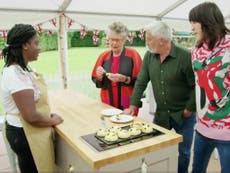GBBO's Japanese week perpetuates the racist stereotype that everything Asian is the same
The problem was the way the ‘Great British Bake Off’ appeared to treat Asian food as interchangeable, because Asians are just one homogenous group, aren’t they?

Your support helps us to tell the story
From reproductive rights to climate change to Big Tech, The Independent is on the ground when the story is developing. Whether it's investigating the financials of Elon Musk's pro-Trump PAC or producing our latest documentary, 'The A Word', which shines a light on the American women fighting for reproductive rights, we know how important it is to parse out the facts from the messaging.
At such a critical moment in US history, we need reporters on the ground. Your donation allows us to keep sending journalists to speak to both sides of the story.
The Independent is trusted by Americans across the entire political spectrum. And unlike many other quality news outlets, we choose not to lock Americans out of our reporting and analysis with paywalls. We believe quality journalism should be available to everyone, paid for by those who can afford it.
Your support makes all the difference.“Japanese week? Is this because Paul Hollywood went to Japan and was mind blown when he found out they make bread?” I asked my partner incredulously when this week’s episode of The Great British Bake Off started.
As the episode unfolded, it became obvious that the "Japanese” theme was much broader – it seemed to encompass the entirety of Asia by the end of the first challenge. A factory line of steamed buns – which, by the way, originated from north China – with Chinese, Indian and western fillings made their way into the judges’ mouths, much to the chagrin of many Asians who tuned in.
Laura’s buns were straight-up Chinese char siew buns with their sticky pork belly filling, similar to the type you get with a dim sum meal; Peter stuffed a (Chinese? Thai?) stir fry into his lamb buns; and Marc’s dahl buns made me grimace just imagining the lack of texture.
Only two bakers used anything resembling Japanese fillings. Dave deserved some credit for his katsu curry buns, despite the fact they lacked any katsu, making them just curry buns. Hermine’s nikuman buns were the most authentically Japanese version of steamed buns.
It isn’t that there was anything inherently wrong with filling steamed buns with cheese and gherkins and dahl – for the most part, I have no issue with the concept of fusion food – the problem was the way GBBO appeared to treat Asian food as interchangeable. It perpetuated the racist stereotype that everything Asian must be the same, because they’re just one homogenous group, aren’t they?
Numerous tweets on #GBBO popped up, saying former contestant Kim-Joy would have been perfect for Japanese week. No disrespect to Kim-Joy, an amazingly talented baker – but why would she have been perfect for Japanese week? She is half Malaysian Chinese, just like me. We have nothing to do with the Japanese, except for their colonisation of my home country.
Worst of all was the “kawaii” theme of the showstopper round. As Noel Fielding explained: “Kawaii is a style rooted in Japanese culture that means all things cute and charming.”
Kawaii is indeed a very Japanese concept and style, but it essentially meant nothing in this episode of GBBO, other than “make a cute cake”. Why are we diminishing and infantilising a cuisine that has deep traditional roots and is especially known for its extreme attention to detail?
Contestants did not make use of ingredients commonly used in Japanese desserts, like black sesame, red bean, sakura or peanuts. Matcha and yuzu were used by a handful of people, whilst Peter’s shuttlecock cake “Dizzy”, while cute, had nothing to do with Japan, where the most popular sports are tennis, sumo and baseball.
No one tried their hand at making mochi or dorayaki. Not a single melon pan appeared on the screen, or a fresh cream roll, two highly popular items in Japanese patisserie. Not even a Japanese soufflé pancake, the darling of TikTok for months, was whispered of! There wasn’t even a Hello Kitty cake, the very epitome of all things kawaii.
It did not help that during the entire episode, all I could think of was Paul Hollywood Eats Japan, which aired on Channel 4 in April. The series was branded as “racist”, “cringeworthy” and “xenophobic” by viewers, who found Hollywood’s assumption that the Japanese only are “rice and noodles” shockingly ignorant. His utter shock when he discovered that not only did the Japanese know about bread, they were good at making it too, was not exactly a proud moment in British television history.
Last night’s episode was met with incredulity and disappointment from other Asian people – notably, Torchwood actress Naoko Mori, who said she was outright offended as a Japanese person. She described the episode as a “lazy bake of an out-of-date, out-of-a-packet mix of ‘Chinese, Japanese, Whatever’ East Asian theme, served with a dollop of the rather passé and yawn stereotype of kawaii”.
“Not only was this insulting to us Japanese and our culture, you also likely insulted the Chinese, as well as the intelligence of a great many viewers of GBBO, who all know the difference between the two and that Baos (steamed buns) are Chinese,” she added in a Twitter thread after the episode aired.
“A tiny token sprinkle of Matcha powder on a pancake doth not a Japanese make. Nor bake. Please. Do better.”



Join our commenting forum
Join thought-provoking conversations, follow other Independent readers and see their replies
Comments